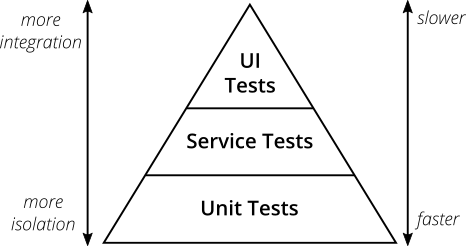
On Test Automation:

From: https://martinfowler.com/articles/practical-test-pyramid.html
Original test pyramid consists of three layers that your test suite should consist of (bottom to top):
Model is a tad simplistic in today’s world. Key take aways:
Two types:
Solitary are tests that stub all collaborators
Sociable are tests that allow talking to real collaborators
if I enter values x and y, will the result be z?
instead of
if I enter x and y, will the method call class A first, then call class B and then return the result of class A plus the result of class B?
Don’t test trivial code
A good structure for all your tests (this is not limited to unit tests) is this one:
Or, Arrange, Act, Assert
Let's take a simplified version of the ExampleController class:
@RestController
public class ExampleController {
private final PersonRepository personRepo;
@Autowired
public ExampleController(final PersonRepository personRepo) {
this.personRepo = personRepo;
}
@GetMapping("/hello/{lastName}")
public String hello(@PathVariable final String lastName) {
Optional<Person> foundPerson = personRepo.findByLastName(lastName);
return foundPerson
.map(person -> String.format("Hello %s %s!",
person.getFirstName(),
person.getLastName()))
.orElse(String.format("Who is this '%s' you're talking about?",
lastName));
}
}A unit test for the hello(lastname) method could look like this:
public class ExampleControllerTest {
private ExampleController subject;
@Mock
private PersonRepository personRepo;
@Before
public void setUp() throws Exception {
initMocks(this);
subject = new ExampleController(personRepo);
}
@Test
public void shouldReturnFullNameOfAPerson() throws Exception {
Person peter = new Person("Peter", "Pan");
given(personRepo.findByLastName("Pan"))
.willReturn(Optional.of(peter));
String greeting = subject.hello("Pan");
assertThat(greeting, is("Hello Peter Pan!"));
}
@Test
public void shouldTellIfPersonIsUnknown() throws Exception {
given(personRepo.findByLastName(anyString()))
.willReturn(Optional.empty());
String greeting = subject.hello("Pan");
assertThat(greeting, is("Who is this 'Pan' you're talking about?"));
}
}When writing unit tests these are usually the parts you leave out in order to come up with better isolation and faster tests. Still, your application will interact with other parts and this needs to be tested. Integration Tests are there to help. They test the integration of your application with all the parts that live outside of your application.

DB:
It just extends the CrudRepository interface and provides a single method header. The rest is Spring magic.
public interface PersonRepository extends CrudRepository<Person, String> {
Optional<Person> findByLastName(String lastName);
}
Application:
Splitting your system into many small services often means that these services need to communicate with each other via certain (hopefully well-defined, sometimes accidentally grown) interfaces.

A naive implementation of CDC tests can be as simple as firing requests against an API and assert that the responses contain everything you need. You then package these tests as an executable (.gem, .jar, .sh) and upload it somewhere the other team can fetch it (e.g. an artifact repository like Artifactory).
@Pact(consumer="test_consumer")
public RequestResponsePact createPact(PactDslWithProvider builder) throws IOException {
return builder
.given("weather forecast data")
.uponReceiving("a request for a weather request for Hamburg")
.path("/some-test-api-key/53.5511,9.9937")
.method("GET")
.willRespondWith()
.status(200)
.body(FileLoader.read("classpath:weatherApiResponse.json"),
ContentType.APPLICATION_JSON)
.toPact();
}
@Test
@PactVerification("weather_provider")
public void shouldFetchWeatherInformation() throws Exception {
Optional<WeatherResponse> weatherResponse = weatherClient.fetchWeather();
assertThat(weatherResponse.isPresent(), is(true));
assertThat(weatherResponse.get().getSummary(), is("Rain"));
}
}UI tests test that the user interface of your application works correctly. User input should trigger the right actions, data should be presented to the user, the UI state should change as expected.

Testing your deployed application via its user interface is the most end-to-end way you could test your application. The previously described, webdriver driven UI tests are a good example of end-to-end tests.

@RunWith(SpringRunner.class)
@SpringBootTest(webEnvironment = SpringBootTest.WebEnvironment.RANDOM_PORT)
public class HelloE2ESeleniumTest {
private WebDriver driver;
@LocalServerPort
private int port;
@BeforeClass
public static void setUpClass() throws Exception {
ChromeDriverManager.getInstance().setup();
}
@Before
public void setUp() throws Exception {
driver = new ChromeDriver();
}
@After
public void tearDown() {
driver.close();
}
@Test
public void helloPageHasTextHelloWorld() {
driver.get(String.format("http://127.0.0.1:%s/hello", port));
assertThat(driver.findElement(By.tagName("body")).getText(), containsString("Hello World!"));
}
}The higher you move up in your test pyramid the more likely you enter the realms of testing whether the features you're building work correctly from a user's perspective. You can treat your application as a black box and shift the focus in your tests from
when I enter the values x and y, the return value should be z
towards
given there's a logged in user
and there's an article "bicycle"
when the user navigates to the "bicycle" article's detail page
and clicks the "add to basket" button
then the article "bicycle" should be in their shopping basket# a sample acceptance test in Python
def test_add_to_basket():
# given
user = a_user_with_empty_basket()
user.login()
bicycle = article(name="bicycle", price=100)
# when
article_page.add_to_.basket(bicycle)
# then
assert user.basket.contains(bicycle)Even the most diligent test automation efforts are not perfect. Sometimes you miss certain edge cases in your automated tests. Sometimes it's nearly impossible to detect a particular bug by writing a unit test. Certain quality issues don't even become apparent within your automated tests (think about design or usability). Despite your best intentions with regards to test automation, manual testing of some sorts is still a good idea.

It is a manual testing approach that emphasises the tester's freedom and creativity to spot quality issues in a running system. Simply take some time on a regular schedule, roll up your sleeves and try to break your application. Use a destructive mindset and come up with ways to provoke issues and errors in your application. Document everything you find for later. Watch out for bugs, design issues, slow response times, missing or misleading error messages and everything else that would annoy you as a user of your software.
As with writing code in general, coming up with good and clean test code takes great care. Here are some more hints for coming up with maintainable test code before you go ahead and hack away on your automated test suite:
DAMP (Descriptive And Meaningful Phrases) promotes the readability of the code.
To maintain code, you first need to understand the code. To understand it, you have to read it. Consider for a moment how much time you spend reading code. It's a lot. DAMP increases maintainability by reducing the time necessary to read and understand the code.
DRY (Don't repeat yourself) promotes the orthogonality of the code.
Removing duplication ensures that every concept in the system has a single authoritative representation in the code. A change to a single business concept results in a single change to the code. DRY increases maintainability by isolating change (risk) to only those parts of the system that must change.